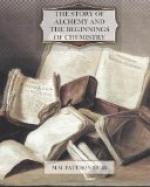We now know that many compounds exist which are formed by the union of the same quantities by weight of the same elements, and, nevertheless, differ in properties; modern chemistry explains this fact by saying that the properties of a substance depend, not only on the kind of atoms which compose the minute particles of a compound, and the number of atoms of each kind, but also on the mode of arrangement of the atoms.[3] The same doctrine was taught by Lucretius, two thousand years ago. “It often makes a great difference,” he said, “with what things, and in what positions the same first-beginnings are held in union, and what motions they mutually impart and receive.” For instance, certain atoms may be so arranged at one time as to produce fire, and, at another time, the arrangement of the same atoms may be such that the result is a fir-tree. The differences between the colours of things are said by Lucretius to be due to differences in the arrangements and motions of atoms. As the colour of the sea when wind lashes it into foam is different from the colour when the waters are at rest, so do the colours of things change when the atoms whereof the things are composed change from one arrangement to another, or from sluggish movements to rapid and tumultuous motions.
[3] See the chapter Molecular
Architecture in the Story of
the Chemical Elements.
Lucretius pictured a solid substance as a vast number of atoms squeezed closely together, a liquid as composed of not so many atoms less tightly packed, and a gas as a comparatively small number of atoms with considerable freedom of motion. Essentially the same picture is presented by the molecular theory of to-day.
To meet the objection that atoms are invisible, and therefore cannot exist, Lucretius enumerates many things we cannot see although we know they exist. No one doubts the existence of winds, heat, cold and smells; yet no one has seen the wind, or heat, or cold, or a smell. Clothes become moist when hung near the sea, and dry when spread in the sunshine; but no one has seen the moisture entering or leaving the clothes. A pavement trodden by many feet is worn away; but the minute particles are removed without our eyes being able to see them.
Another objector urges—“You say the atoms are always moving, yet the things we look at, which you assert to be vast numbers of moving atoms, are often motionless.” Him Lucretius answers by an analogy. “And herein you need not wonder at this, that though the first-beginnings of things are all in motion, yet the sum is seen to rest in supreme repose, unless when a thing exhibits motions with its individual body. For all the nature of first things lies far away from our senses, beneath their ken; and, therefore, since they are themselves beyond what you can see, they must withdraw from sight their motion as well; and the more so, that the things which we can see do yet often conceal their motions




